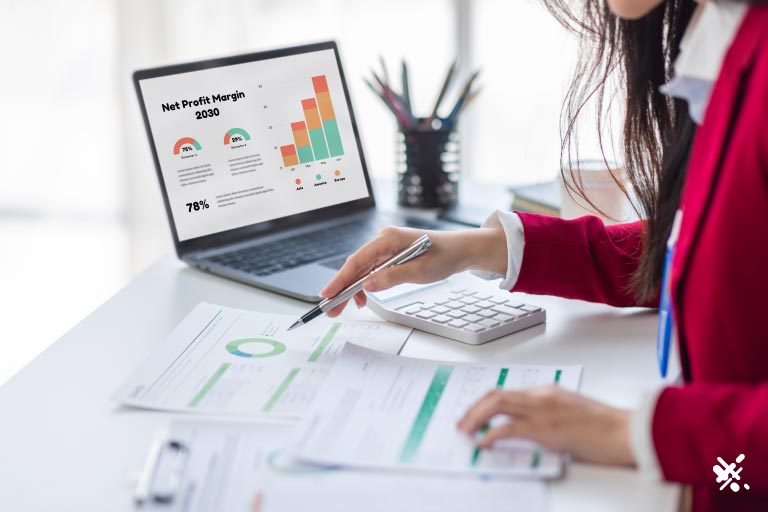Those outside the profession of business management sometimes toss around business-related terms, often with potentially little connection to their exact meaning. This is true even for small business owners. Pinning down the jargon can sometimes open up an impactful discussion about business strategy. So, what is the difference between markup and margin?
Profit Markup vs. Margin
What’s the difference between margin and markup? In simplest terms, markup focuses on how much you charge customers, while profit margin focuses on how much money you make.
You might say—in other words—that markup focuses on the customer, while margin focuses on the business. To distill the idea down further, markup is about price, and margin is about profit. And both of these numbers will revolve around the Cost of Goods Sold or COGS.
The COGS includes all direct costs in selling the item to the customer, such as materials and labor. It excludes all indirect costs such as overhead, sales, and marketing. We’ll get into the exact components of the COGS later. For now, let’s look at how to calculate price margin and profit.

How To Calculate Margin vs. Markup
The profit margin formula looks like this:
(Selling Price – COGS) / (Selling Price) = Profit Margin Percentage
This formula will show you the profit margin expressed as a percentage. There is another formula that will show you profit margin expressed as a dollar amount, and it is:
Selling Price – COGS = Profit Margin in Dollars
However, this formula may be less useful for making big-picture decisions. Percentages are better at telling you how much profit you are squeezing out of every olive…or whatever else you’re selling if not olive oil.
Now, onto the formula for marking up prices:
Selling Price – COGS = Markup in Dollars
You might be scratching your head here because this particular formula for the dollar amount seems the same as the one for margin. Yes, indeed…when viewed as a dollar amount, markup and margin will probably be the same. But to find the markup percentage, your formula will indeed be different:
(Selling Price – COGS) / (COGS) = Markup Percentage
Margin and Markup Formulas With An Example
Let’s return to olive oil since we mentioned it earlier. Say you are operating a boutique store that sells olive oil, olives, and olive-themed ceramic kitchenware (you gotta go big or go home). Focusing only on the bottles of olive oil, let’s say they cost you $10 per bottle.
That $10 is your COGS. The labor and materials are all bundled up in this number by your supplier. Of course, if these olives are picked from your own grove, then that number might be different (probably lower, as the supplier also has their own markup).
Now, let’s look at the price that customers are paying. Suppose you charge $15 per one-liter bottle. That’s a little more expensive than a typical grocery store, but you are selling a boutique product here. Chef’s kiss!
First, let’s look at the profit margin and markup viewed as a dollar amount:
Selling Price – COGS = Markup and/or Profit Margin in Dollars
$15 – $10 = $5 per bottle
Now, you can look around the store whenever you’re bored and contemplate each bottle as generating $5. But while it might be entertaining to view the visage of Abraham Lincoln floating above each bottle, this haunting experience cannot generate big-picture guidance. For that, you need some percentages.
(Selling Price – COGS) / (Selling Price) = Profit Margin Percentage
($15 – $10) / ($15) = $5 / $15 = .33 or 33%
This formula tells you that you are making a 33% profit margin on each and every bottle. Now, you have a more informative number to work with. This is an excellent profit margin, especially considering retail profit margins hover around 3%. Of course, typical profit margins vary widely based on industry.

Profit Margins Need to Consider Overhead Costs
However, the picture is not complete. That’s because you’re not really making 33% on each bottle. Remember, you have overhead involved, like rent, employee wages, insurance, marketing, and utilities. For now, let’s leave the profit margin percentage as it is and come back to all that later.
Let’s finish up with the same bottle’s markup calculation:
(Selling Price – COGS) / (COGS) = Markup Percentage
($15 – $10) / ($10) = $5 / $10 = .50 or 50%
As you can see, the markup on each and every bottle is 50%, meaning you are taking 50% of the bottle’s cost and tacking it on to the bottle for the final price of a product. Incidentally (or perhaps by the design of this article’s author), this is a typical retail markup referred to as a “keystone” markup.
Is There a Difference Between Products or Services?
Your pricing strategy may change whether you are selling goods or services. With a pure service, there may be no cost of production or very little. Instead of percentages, calculating to set prices, there will be more examination of industry standards, the value of the services you render, and the customer.
Some business pundits argue that service-based businesses consequently have a better profit margin. And they may be right. While 3% is not a bad profit margin for retailers, service-based businesses might see profit margins of 30%. Service-based businesses might benefit from more complex calculations, which we will look at next.
Are There Different Types of Profit Margin?
There are actually three types of profit margins in accounting: gross profit, operating profit, and net profit. While the formulas and particulars are different for each one, all three revolve around one thing: telling you how efficiently a business runs.

Gross Profit Margin
Gross profit is the simplest metric of profitability. It tells you all the profit made on each item after the cost of goods sold (COGS) is deducted. We have actually covered gross profit margin in greater depth above. However, in doing so, we focused on the profit margin for individual items.
While determining the profit margin for each item is important, sometimes you need more of a bird’s eye view. To determine the gross profit margin for the entirety of your business inventory, you will want to change some of the terminology in your formula. Instead of…
(Selling Price – COGS) / (Selling Price) = Profit Margin Percentage
You will be looking at…
(Net Sales – COGS) / (Net Sales) = Gross Profit Margin as a Percentage
Let’s go back to our previous olive boutique example. Let’s say that the total quarterly sales for this retail location were $100,000, and the cost of all goods was $75,000. Obviously, more accounting is involved in determining the COGS since the COGS for a bottle of olive oil differs from that of an apron or a ceramic serving dish. However, we are trying to keep our example simple for the sake of illustration.
(Net Sales – COGS) / (Net Sales) = Gross Profit Margin as a Percentage
($100,000 – $75,000) / ($100,000) = .25 or 25%
This 25% profit margin is still excellent. Note that it is lower than the 33% profit margin you’re making on bottles of olive oil. This number may be coming down due to other items that are less “profitable.”
However, running a business is more than income statements and total costs. There is also customer experience, without which there may be no bottom line. In this case, maybe bottles of olive oil are indeed your most profitable item.
But maybe you know from previous experience that only selling bottles of olive oil brings less foot traffic into your store. Perhaps you’ve seen through trial and error that offering a wider variety of products offers more sales.
And perhaps you’ve seen that some products are just not profitable, bringing your overall profit down. Having some numbers to work with can show you how to fine-tune your inventory so you can make decisions about what to do next.
Operating Profit Margin
Operating profit margin is a more complex formula that considers overhead costs like operations, administration, and sales expenses (such as marketing). Note that this number excludes taxes, debts, and other non-operational expenses. These expenses are often bundled into the term Selling, General, and Administrative Expenses (SG&A).
The formula here is:
[Net Sales – (COGS + SG&A)] / (Net Sales) = Operating Profit Margin as a Percentage
Let’s return to your example once again. Recall that the store made $100,000 in net sales for that quarter, and the COGS was $75,000. Suppose utilities are wrapped up in the lease, and all other expenses, including the lease, come to about $20,000 per quarter.
[$100,000 – ($75,000 + $20,000)] / ($100,000) = ($100,000 – $95,000) / ($100,000) = 5%
Wow! This number looks less appealing than the gross profit margin calculated above. Generally speaking, retailers want their OPM (operating profit margin) to hover between 10% to 20%. As this number falls outside that range, some changes will need to be made.

Net Profit Margin
Net Profit Margin is really “where the money is.” This involves subtracting the cost of everything from the net revenue: COGS, SG&A, other expenses, interest on debts, and taxes. The formula looks like this:
(Net Sales – COGS – SG&A – OTE – I – T) / (Net Sales) = Net Profit Margin
Sometimes, you will see SG&A represented as OPE or operating expenses. The formula is essentially the same, even with different terms:
(Net Sales – COGS – OPE – OTE – I – T) / (Net Sales) = Net Profit Margin
Now, let’s return to our olive store example, using the same figures as before: $100,000 in gross sales, $75,000 in COGS, and $20,000 in operating expenses. For simplicity, Let’s also suggest that the business has no other operating expenses. Let’s suggest a small outstanding debt with interest payments of about $100 per month or $300 per quarter.
And with just $20,000 per year in profits (at least according to our example), taxes will also be very low. Let’s suppose the business is structured as an LLC for simplicity’s sake. With that kind of income, the business will be in the 12% tax bracket, or about $600 quarterly.
($100,000 – $75,000 – $20,000 – $0 – $300 – $600) / (Net Sales) = Net Profit Margin
($4,100) / ($100,000) = 4.1% net profit margin
As mentioned earlier, things could improve at this particular boutique. While a 4.1% return on some investments is not bad, it doesn’t seem to yield an amount of money that somebody (like the owner) could live off of. Of course, some investors own businesses that lose money, intending to write those losses off against their assets that produce income. But we’re not going to go into that here.
How To Increase Profit Margin
So now on to the question that every business owner wants to know the answer to: how can you increase your profit margins? There are several ways to go about this. However, choosing which strategy or strategies to use must also factor in customer experience and brand reputation. That said, let’s take a look…
#1: Increase Your Prices
Increasing your prices certainly seems obvious and is a common go-to for businesses. However, it leaves a bad (very bad) taste in consumer mouths. Everybody has that one grandparent who talks about buying milk, bread, and eggs for a nickel back in the day. Today, eggs have become the subject of memes: I won’t tell anyone I won the lottery…but there will be signs.
Of course, a significant part of that is the rampant inflation of the past few years. But that only serves to prove our point. Prices have increased because businesses have a choice: let their profit margins dip into uncomfortable territory or upset consumers.
Remember that price increases do not have to be an all-or-nothing game. There are subtle ways to go about it. For instance, you could increase the price of select products while retaining or even lowering the price of others. This will mitigate consumer sentiment about price increases, especially if you play up the sales with some effective marketing.
#2: Do More, With Less
Doing more with less is also an easy go-to but with similar tradeoffs. While price increases can upset your end users (e.g., the customer), scaling back can upset your employees. That’s because human capital may be the very thing that needs to be scaled back. Some businesses spend 70% of their budget on labor costs like payroll and accounting.
There may be ways to reduce redundancies in your staffing or payroll expenditures in general. One tried and true method that larger companies typically use (especially in retail) is to hire only part-time employees. This way, companies can avoid paying for certain benefits while retaining the amount of help they need.

#3: Engage Your Customers
New customer acquisition can cost five times as much as retaining a current customer. According to one study, businesses that increase their customer retention by just 5% can increase their profits from 25% up to 95%. That said, gearing your marketing efforts toward your existing fan base might greatly increase profit margins.
Are you collecting customer contact info at the point of sale? Do you have some sort of reward program that can incentivize continued engagement with your business? If you run online ads, do you have a way to set up retargeting campaigns? All of these practices can bring down your marketing costs, which in turn improves your profit margin.
#4: Streamline Your Processes
Many small business owners rely on legacy systems, outdated hardware, and manual labor to manage their business data. Doctor’s offices are particularly guilty of this, continuing to use paper records. In any case, no matter what type of business you run, streamlining the processes of your business can eliminate errors and reduce spending.
For example, accounting software integrated into your point-of-sale software can eliminate hours of accounting and bookkeeping. Inventory software integrated into your point of sale can eliminate hours of inventory and reduce extra or unnecessary orders. And software can also be used to effectively juggle employee scheduling so there is no overlap or idle time.
You might have noticed that a lot of the above discussion comes down to one word: software. Software applications these days are almost always cloud-based subscriptions, meaning they do not require any storage or maintenance on premises.
Subscribers can access the platform remotely anywhere, paying a low monthly fee. Business owners recognize software’s convenience to bridge operational gaps, with 86% transitioning to an increased usage of technology platforms for daily operations.
#5: Review Your Contracts
One of the first things an accountant or consultant will do with a business owner is review their consistent expenses. This can be an opportunity to identify hidden costs, eating away at the profit margin. In suggesting a “review of contracts,” we mean reviewing all contractual relationships, including debt and taxes.
Did you know that as many as 93% of business owners overpay their taxes? This could be because they are not writing off all their expenses. They also might not be taking advantage of certain tax breaks unique to their industry.
Did you know that 80% of businesses are overpaying for utilities? Telecom and insurance are two other areas where businesses typically overpay. Then there are obviously the contracts you have with your suppliers.
Of course, every business owner knows to look for wholesale prices. But perhaps there are some better vendors out there regarding price and quality. Unless you have a personal reason not to, you can always switch suppliers and vendors. You can also go to your suppliers with information about a competitor and ask if they can match them.

#6: Conduct Market Research
Knowing your customers is a big part of improving your profit margin. That’s because responding to customers can increase your net revenue. Ideally, you want to increase your revenue while decreasing your operating expenses. But even if you can’t decrease your expenses, increasing your revenue will certainly increase your profit margin.
Of course, there are ways to do that without making fundamental changes, such as price increases (as mentioned above). You can also stay up-to-date on larger consumer trends, such as putting out holiday-themed items in November and December. But what about just selling more of what sells and selling less of what does not?
Once again, software is key. Analytic software integrated into your point of sale can give you detailed and nuanced information on your sales numbers. You can see what items sell and when they sell (day and time, even). You can also see what items customers typically like to purchase with what…perhaps some olive oil and ceramic dipping bowl.
Then, you can use this information to change the store layout or your inventory. If a certain item is not selling, it may bring down your revenue. Or, there are times when it may be a bestseller. For instance, a red apron that says “Olive You” surrounded by hearts may pull down your profit margins in July but may send them soaring in February.
How To Calculate Cost of Goods
Now, back to the Cost of Goods Sold. How exactly do you determine this number? The most basic formula for determining this number is:
Beginning Inventory + Purchases During The Period – Ending Inventory = COGS
Let’s say you are looking at this annually, and at the beginning of the year, have $50,000 worth of inventory—olive oil, olives, apparel, kitchenware, and maybe some dancing plush toys (can’t ever go wrong with those). Over the year, you purchase $100,000 more in inventory and sell $75,000 worth.
$100,000 + $50,000 – $75,000 = $75,000 in COGS
Incidentally, this is the number we have used in our previous examples.
Are There Different Formulas for COGS?
There are indeed FIFO, LIFO, ACM, and SIM. These stand for First In First Out, Last In First Out, Average Cost Method, and Special Identification Method. A discussion of these different methodologies starts to get into some heavy accounting territory. So we will leave that for a different day.
Remember that COGS does not include many overhead costs like sales-related labor (e.g., employees), utilities, insurance, taxes, debts, interest, and other operating expenses. COGS focuses on the inventory itself. For most retailers who purchase their goods wholesale from suppliers, the COGS of every item is pretty much wrapped up in its cost.

What Is A Good Profit Margin?
There is not one answer that fits all industries. Utilities tend to hover around 9%, while tobacco sits at 49%. Restaurants average 10%, while banks average 26%. Entertainment averages 11%, while alcohol averages 21%. Other factors influence the answer to this question, such as location and the general economy.
Some business managers suggest that 10% is ideal for retailers, while 20% is excellent, and anything less than 5% merits organizational changes. In the example we looked at above, the profit margin fell below 5%. Organizational change is suggested: changing prices, reducing expenses, and engaging in other strategies.
What is a Good Markup?
And now, back to markup. Much like the question of margin, markup varies from industry to industry. In the grocery business, markups might be around 15% or less, while markups might surpass 60% in the restaurant business. Both places are essentially serving the same product: food. So, what makes one so different from the other?
The answer is all the operating expenses that go on top of the cost of goods sold. A grocery store does have labor costs, just like a restaurant. They have marketing costs as well. However, the labor costs of a restaurant may surpass that of a grocer because raw food needs to be prepared, served, and cleaned up.
Through this example, you see that markup is also contingent on some of the operating experience of the business. Businesses with fewer labor costs and whose products are in the lower stages of a product “lifecycle” can have lower markup, which is why you can pay $18 for a bowl of spaghetti at a restaurant but $8 for twenty times that amount of pasta at Costco.
Remember that 50% is regarded as the “keystone” in retail. Some businesses have very high markups. For instance, most apparel markups range from 100% to 300%. And you might be surprised (or not) to learn that pharmaceutical drugs have markups that might be as high as 5000%. It all depends on what kind of product or service you sell.
How to Calculate Margin and Markup: A Wrap-Up
A significant amount of calculating business expenses relies on big data. This data includes patterns of customer behavior, such as purchases. The best place for capturing that data is not in the accounting books but at the point of sale.
A good payment processor can help your bottom line (profit margin) by giving you the tools you need to make high-level decisions. To learn more, contact us or fill out the form below.
